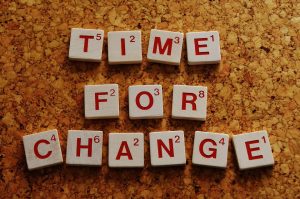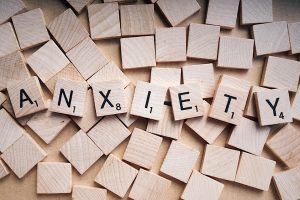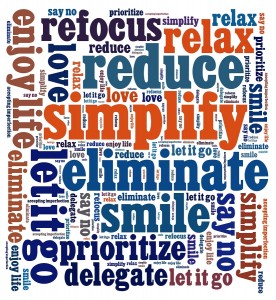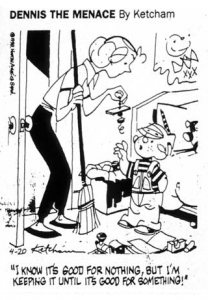
For many, a New Year brings new ideas, new wishes and renewed hope. Maybe you’ve thought about getting organized but haven’t acted on it.
Getting organized takes some courage. The courage to take actions that result in change. It may take many steps – baby steps. But every step counts!!
Maybe you’ve had nagging thoughts. These thoughts become annoying or stressful. They sound like:

Sound familiar?
Let me help you imagine what can follow next.
First, you recognize that you’re having these thoughts. Being conscious causes awareness in the present. You are very Present! This is the first baby step you take.
You realize you want support. You take time to find the “right ” person who will help you get the job done. You inquire by asking others, searching the internet, or hiring a Professional Organizer – more baby steps.
Each baby step demonstrates your courage and adds up.
Even though it feels uncomfortable, you finally decide to reveal the secrets and feelings that are challenging – with courage.
You clear time in your busy schedule and make appointments to organize. You work hand in hand at the scheduled appointment, staying open to guidance and suggestions. You make decisions during the session, and even surprise yourself! Purging items you never thought you could, or would. You let the items go, out of your possession. Some that same day!
At this point you feel pleased with your progress, and the results from your hard work. You experience a sense of accomplishment, freedom, aliveness, motivation, peace. You commit to more work days and see a clearer space and vision for yourself.

All the baby steps have accumulated to cause a personal transformation – within yourself and your space!
Congratulate yourself, it doesn’t matter how long or what it took to get to this point. Take a moment, breathe, and BE. You have earned it!
Who likes change and welcomes it? Most of us fear the unknown, even avoid it. Well, getting organized is a process of change. And, as growth is a byproduct of change, by embracing this change you are embarking into new possibilities of growth. Remember, with every step of the process, change occurs externally and internally.
“Change always comes bearing gifts” Price Pritchett
“We have thoughts, feelings and emotions, but we are not our thoughts feelings or emotions” Frances Vaughn
Mental Clutter is more mysterious and different from physical clutter. It hides, and resides in the mind disguised. It can be defined as an abundance of thoughts, and self-talk swirling around in our headspace! Layers of current thoughts, past thoughts and thoughts waiting to be triggered will occupy the mind space. Then if emotions arise, the mental clarity is gone and the cluttered brain exists.
On one level, mental clutter can be caused by:
On a deeper level, other mind clutter may not show up on your radar screen, depending on how self-aware you are. Things appear as they are, and we say it’s just the way it is!! We are blindsighted by the thought. Here’s one example: perfection. The thought of being perfect exists, regardless of why, or how it is there. You hold onto the belief that being perfect is the way to be and think. There isn’t much freedom in having this thought. It sabotages actions, and brings on negative self-talk.
Here’s what is true: we are in total control of what we choose to think or believe. Although what thoughts are in the mind can come from limiting beliefs you hold on to and live by. Sometimes these are generalizations, ideas or interpretations that you hold on to and then forget you did. At some time you may have felt strongly connected to them but now you’ve grown and changed and they don’t fit! All these thoughts may be laying dormant until something triggers it to surface. Next, you are living a life that’s not yours.
Try looking at where this thought, or belief came from. You may realize the roots of this. With introspection you realize that it doesn’t serve you anymore at this time. It’s time to give it up and free yourself. What I mean by this is, you may have lost touch with what’s really important to you – now, in the present. Maybe at one time all these thoughts, beliefs, and truths matched what was important to you. You can ask yourself, how true is this belief? The end result is living true to who you are, and who you say you are. In any given moment you can “CHOOSE” what you want to think or what doesn’t fit. The choices you make can motivate and uplift your spirit. Staying true to yourself brings inner peace.
Mindfulness and awareness will be the guide for clearing the mental clutter.
The principles of organizing apply here:
Assess what’s going on.
Take Action – Either jot down all that’s in your head until you feel empty. Seek support, like someone to talk or vent to. This helps in getting all the stuff out of your head.
Sort what thoughts to hold on to and why.
Identify what doesn’t serve you anymore. Ask yourself if any of those thoughts are draining you and your energy? Can you rephrase your thoughts so they empower you?
Choice – With acknowledgment, awareness and conscious choice, a clearing takes place. The result can be more head space! This is freeing. You may notice your energy higher. You may feel like you shed a layer or two, feel lighter, and quite positive.
Space has been created and quietness of mind and peace attained – You now have a blank slate.
When your home isn’t peaceful, a place you can retreat to, or a safe haven from the outside world, it will affect you, but how is up to you.
As a professional organizer, I get calls all the time from people expressing thoughts of overwhelm and sharing other complaints such as:
“I can’t live this way anymore”
“I feel stuck”
“I am drowning”
“I don’t know how this happened”
They also tend to express feelings of shame, distress, self doubt, low self esteem, loneliness, and frustration — to name a few! At this point, I reassure them that these feelings aren’t who they are, or who they’ve become. Clutter can’t take away their ‘Greatness’ as a person!
Immediately, I want to assist these people in seeing for themselves that the disorganized mess they have can be fixed with effort and commitment. After listening to their tale, I usually hear some version of “Life wasn’t always this way for me,” or, “My space used to be…” At this point in the conversation, I give a few positive suggestions such as:
It is important to keep in mind that change is a constant, and at times, things become unmanageable temporarily. You can physically clear your clutter and clear the ‘mind chatter’ by having help, support, focus, and intention. One key is to have Patience with yourself. It’s important to take stock of the positives, your accomplishments, and what you are striving to achieve. In doing so, self doubt, shame, loneliness, and low self-esteem can disappear as quick as the clutter, if you are willing to LET IT GO! Remind yourself that life changes and so do you!
Remember this, these thoughts and feelings don’t represent who you are or who you think you have become! The clutter does not define who you are. Each one of us is a perfect, unique energy force.
Please remember your ‘Greatness’!
 Typically in our society, we acquire items, things, and stuff. We use our valuable time to acquire these so called treasures. It may have felt good to collect and accumulate. Yet, when it’s out of control it appears as clutter and usually those feelings change. Overwhelm shows up. That’s the signal, the “red flag”, that it is time to take some action. One action could be evaluating and accessing the reasons you have what you have. We are not talking about items that serve a purpose, are useful, and make your life better.
Typically in our society, we acquire items, things, and stuff. We use our valuable time to acquire these so called treasures. It may have felt good to collect and accumulate. Yet, when it’s out of control it appears as clutter and usually those feelings change. Overwhelm shows up. That’s the signal, the “red flag”, that it is time to take some action. One action could be evaluating and accessing the reasons you have what you have. We are not talking about items that serve a purpose, are useful, and make your life better.
Are you holding on dearly to the “stuff” that:
1. Represents “Who” I am, or “Who” I was, or “Who” I want to become
Do you like any of these “Who’s”? Sometimes they don’t align with who you are presently, or they are reminders of the past, or even reminders of in-completions. If you don’t feel energized or happy with them, then why keep them around?
2. I may need this someday
Future thinking that could keep you up to your eyeballs in excess stuff. It could be said this indicates a lack of trust in the future. Our thoughts can create our reality. If unconsciously your thoughts are coming from a place of lack, you will create that. What do I mean? If you trust that you will have all you need , you will have it!
3. I got this as a gift
Just because your favorite person bought this doesn’t justify saving space for it if you don’t need, want, or like it. Re-gifting or donating gives it a new life from gathering dust or buried in a pile. Using places for unwanted items takes away your precious space.
4. Family relics that have been passed on to me
So maybe you have inherited these things that have no meaning or sentimental value to you. If you feel you want to memorialize the people, choose a few items and get creative. Make a shadow box or a special area to display them. If you will have joy and feel happy seeing these items in your home, then that’s what counts!
5. I feel secure having this/ Can’t have empty space
No matter how many possessions you acquire the need for more will occur. Remember to keep what makes you happy, and give away what you don’t like. If you don’t like empty space, look at why. Also keep in mind that no matter how much you have, keep these areas safe and accessible. This is your home and a place to retreat to from the outside world.
6. It cost so much/got it for free
It’s all relative to how you look at value. Whether you spent more on an item or got it for free it comes down to how you view this. When looking at an item in this category to purge or keep, check out if your beliefs or values around the money are holding you back from making the decision. This awareness may open you up to making a decision based on what you like regardless of the cost.
Looking at these categories and evaluating brings self awareness and conscious choices. This awareness can lead you to taking another step; recognizing what’s behind your decision making. If you choose to recognize these things it might set you free. One being mental clarity and then giving yourself the freedom to make a choice. The choice of physically letting items go that you don’t really want, or keeping what you truly treasure!
 As professional organizer I hear people label themselves especially when they call for help. Usually this occurs while doing an assessment on the phone. Often, the person calling states or describes themselves as a hoarder. My opinion is that, due to reality shows like Hoarders or Buried Alive, people seem to identify themselves from what they see on t.v. People use this label even when they aren’t a hoarder. It’s become a generic label that people use falsely to describe themselves. These days, what you see or hear in the media soon become buzz words used by many. In times prior to reality shows these people may have called themselves pack-rats. They may be defined as people who gather, accumulate, store quantities of items for too long — for many “meaningful” reasons. Generally, hoarding behaviors fall under the category of chronic disorganization.
As professional organizer I hear people label themselves especially when they call for help. Usually this occurs while doing an assessment on the phone. Often, the person calling states or describes themselves as a hoarder. My opinion is that, due to reality shows like Hoarders or Buried Alive, people seem to identify themselves from what they see on t.v. People use this label even when they aren’t a hoarder. It’s become a generic label that people use falsely to describe themselves. These days, what you see or hear in the media soon become buzz words used by many. In times prior to reality shows these people may have called themselves pack-rats. They may be defined as people who gather, accumulate, store quantities of items for too long — for many “meaningful” reasons. Generally, hoarding behaviors fall under the category of chronic disorganization.
With my 10 years of “hands on” experience and educational classes on chronic disorganization, my definition of hoarding is this: Hoarders are people who are emotionally attached to their things and gather excessively beyond the norm. This includes trash as defined as items soiled, damaged, expired, unhealthy, worthless, or nonsensical. They place a higher value on these items and sometimes have irrational reasons why they hold on to them. They will acquire and put themselves in harms way in order to keep these items in their physical space. They will choose to give up all support and interaction with other human beings. What they acquire and choose to keep — become and are — their prized possessions. They will jeopardize their own safety in order to keep these possessions. They can live in filth and squalor. They endanger themselves and the dwelling’s structure and home’s safety. In extreme cases they will become homeless in order to hold onto their prized accumulations.
Hoarding is a clinical term now recognized by the American Psychological Association and is included in their Diagnostic and Statistical Manual (DSM). In the current edition, DSM-V, this disorder, Hoarding is newly defined. After so many years, hoarding is now being studied, researched, and evaluated individually. It also can coexist with several mental disorders and diseases.
Professional Organizers ask pertinent questions when doing an assessment so we can best serve the individuals. We do not judge people, and quite often find people use the “hoarding” term too broadly and too often.This is so sad, CLUTTER will make anyone feel unhappy.
Labeling yourself can be self defeating. Labels can help identify and create awareness for change. But labeling yourself as a hoarder can ultimately give you a negative self image. It will dis-empower you; its negative connotations will not forward your growth or the process. Support is important, especially if you feel like your living space is out of control. Please get assistance either from a healthcare professional, your physician, a professional organizer specializing in chronic disorganization, or from all 3 sources. The key is awareness, getting help, and taking action!
The Institute for Challenging Disorganization offers this:
“Chronic disorganization is having a past history of disorganization in which self-help efforts to change have failed, an undermining of current quality of life due to disorganization, and the expectation of future disorganization.
FOR MORE INFO, please check out this link: http://www.challengingdisorganization.org/
“We can’t solve problems by using the same kind of thinking we used when we created them” — Albert Einstein
 Why Haven’t I Done This Before?
Why Haven’t I Done This Before?
Are you asking yourself any of these questions? What does this mean?
The concept of shopping in your closet is- Know what you own, Create options you love, Wear what looks good & Makes you feel good, and Add what you are missing.
Simply, it’s seeing what you have, distinguishing what your patterns are, coordinating items, and getting into action!
SUGGESTION: Have a pen & paper ready to record your observations
It’s time to get into your closet. If you can’t manage that, then you should clear a path into it, maybe with some professional help from an organizer!
1. Observe it first. Then, if possible group like items together…pants with pants, sweaters with sweaters and so on.
2. Notice how many of the same item you have in the same color ( sound familiar!) For example- You notice you have 12 black turtlenecks? – couldn’t find them and purchased more? Did you get them on sale? Are they in your favorite color or colors?
3. Next is to take an inventory of what’s in every category. First it’s a broad look. This will inform you of what’s missing. Also you are gathering information about your colors, styles you tend to buy, styles you prefer to wear, and the correct size that fits now! At this point, you can check sizes and conditions of the garments. Pull out soiled, damaged, items for repair, outdated, and items you don’t feel good in and are the incorrect size. Now is the time to purge and bag the items “Leaving” your closet (if you haven’t done so already!) Look for what stands out, like the items you like or don’t like and the items that fit. All the items you want from each category that remain will become your “core” wardrobe.
4. At this point you will have noticed your buying patterns. Ask yourself questions, because this might help you reveal the “why’s” to what you have in your closet. Now you can make some conscious choices. It would benefit you to stay open to this exercise!
5. This is the time you can start coordinating outfits. You can split up sets and use items separately. You may have purged a part of a set which is fine! If this isn’t your forte then you may consider getting some help from a wardrobe consultant/organizer.
You can have a lot of fun creating new outfits and blending pieces together. At this point you may need to list the colors or items missing for these coordinates/outfits. This will become your new shopping list. Start using your new insights. These insights about your buying habits will help you from buying items that you don’t need or want.
Using this method will result in some new fresh looks for the season. Generally using items you already had that either you couldn’t see, find or realize could work with something else. This might improve your impulse buying! Also another outcome of this will be, that you have cleared your closet space and can practice staying organized!
Have some fun with this and let your creative juices flow!!